When we had just moved to our current residence, I had a chat with our new neighbor Klaas. At a certain moment we got talking about nature and birds. Not that strange if you look at what a beautiful bird rich environment we moved to. In the decision to move into this house, the grove behind our garden was very important, if not decisive. A choice that we still don’t regret. Anyway, we were talking about birds and whether it was as a test of my bird knowledge I don’t remember, but the neighbor asked me if I had ever seen the Bombycilla garrulus. I knew a number of scientific bird names, but this one didn’t sound familiar to me. “Well, just look it up”, he said. So when I got back home, my first action was to ask Google :-). I was curious what I would find as a search result. The answer was the Bohemian waxwing. Of course I knew that bird, but unfortunately I had never seen it.
Invasion of birds
Like the kingfisher, the Bohemian waxwing is a species that you don’t immediately expect in the Netherlands in terms of colour. It has something Oriëntal, not surprisingly because there is also a Japanese waxwing (Bombycilla japonica) which – unfortunately – is often kept in Europe as a caged bird. Our Bohemian waxwings are mainly found in Scandinavia and the Baltic states. When winter approaches and their daily food of insects and nuts is in danger, they migrate to the south to warmer places. They also adjust their menu, because in winter they often look for berries, especially those from the guelder rose (Viburnum opulus), rowan (Sorbus) and hawthorn (Crataegus). Usually they enter the Netherlands in larger groups and thus form a true invasion. The largest groups are usually seen in the province of Groningen in the north of the Netherlands, where the Scandinavian birds land after crossing the North Sea. Groups of 25 to 50 birds are no exception. As the invasion progresses and the cold front moves further to the south, the birds spread more inland where the flock sizes decrease and the birds are then often observed in Belgium and Northern France.
Bringer of death
In Dutch this bird is called ‘pestvogel’, translated ‘plague bird’ in English. This strange Dutch name has its origin in the Middle Ages. The invasion of the Bohemian waxwing would sometimes coincide with an increase in the number of plague cases and so both events were linked by the people. A beautifully coloured bird became regarded as the bringer of death. The ancient Romans already knew the bird, and they gave it the name ‘avis incendiaria’, which means fire bird. Presumably referring to the bright yellow tips of the wing and tail pins. The English came up with a more exotic name for the bird: Bohemian waxwing. Waxwing comes from the red waxy appearance of some of its feather tips. They look like drops of sealing wax. The prefix Bohemian is a translation of the earlier taxonomic names, based on the name Garrulus Bohemicus, a designation first employed by Conrad Gesner. Gesner used Bohemian because in folk belief the Czech lands were considered as the source of these birds.
Talkative silk-tail
Linnaeus first described this bird in 1758 as Lanius garrulus. Lanius refers to the same genus as the great grey shrike (Lanius excubitor). In 1808 the waxwings were moved by Vieillot to their own genus Bombycilla and the bird got its modern name Bombycilla garrulus.This literally means ‘talkative silktail’. The genus name Bombycilla comes from the Greek ‘bombux’ which means ‘silk’ and Modern Latin ‘cilla’ which means ‘tail’. It is a direct translation of the German name ‘Seidenschwanz’ and it refers to the silky-soft plumage of the bird. The species name garrulus is Latin for talkative, which is a reference to the supposed likeness of the Eurasian jay (Garrulus glandarius) and not to the chatter of the waxwing.
Berry bushes in the garden
It is a really beautiful bird, the Bohemian waxwing. And not at all shy, they can easily be approached up to a few meters. Probably because they encounter few people in the areas they usually reside and have therefore not learned to fear people. If any waxwings are reported in your neighborhood, I can recommend going to that spot and watch them. Often they won’t move on to a different spot straight away but stay around for a couple of days before they move on, leaving an empty berry bush. In our front and back garden we have planted a number of berry bushes, including the guelder rose and the medlar (Mespilus germanica), which they also love. The bushes are not yet fully grown, but in the winter of 2017 I have already seen some waxwings in our village. Someday they will come to pick the fruit from our bushes, it’s a matter of time.
Unfortunately my neighbor Klaas won’t be able to experience this anymore. After a brief illness he passed away on August 27th 2018. For me he will always live on in the Bombycilla garrulus. Incidentally, I found out years ago it was the only scientific bird name he knew.
Sources:
- www.wnve.nl (in Dutch)
- www.merriam-webster.com
- en.wikipedia.org
This post was originally published in Dutch on November 24th 2016, except for the last paragraph.



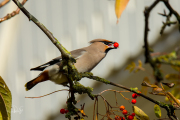
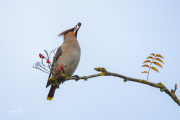
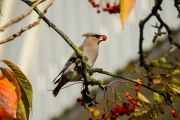
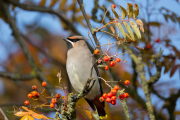
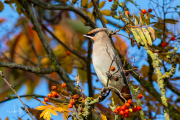
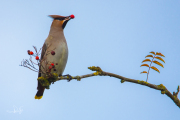
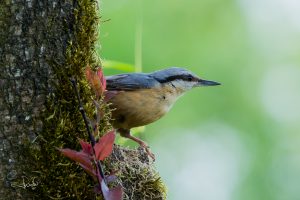
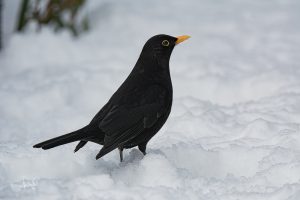

Thank you for this wonderful post. I came here looking for an answer to the question “why are Bohemian waxwings called plague birds ?” and not only did I get an answer, I also enjoyed reading your article and looking at your pictures immensely. Thank you very much.
You’re very welcome Karen! It is very nice to read that you ended up on my website and that you received an answer to your question.